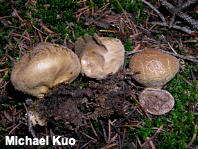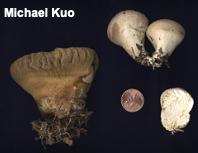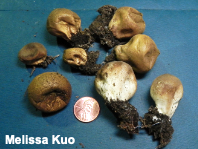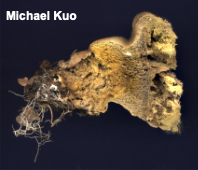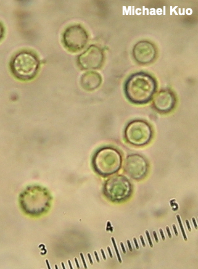| Major Groups > Puffballs > Lycoperdon umbrinum |

|
Lycoperdon umbrinum [ Basidiomycota > Agaricales > Agaricaceae > Lycoperdon . . . ] by Michael Kuo Like several North American puffballs, Lycoperdon umbrinum is usually shaped like an inverted pear (as the result of its sterile base) and is about the size of a golf ball or, at most, a tennis ball. It features a granular and spiny surface, but the spines when present are very short (1 mm long or shorter) and are soft and narrow, rather than cone-shaped and wide-based. The surface—especially on the top—is usually a shade of brown, and in most specimens the entire puffball becomes brown fairly early in development. Lycoperdon molle is very similar—similar enough that its name has been interchanged with Lycoperdon umbrinum for the same mushrooms by the same mycologists (e.g. Smith 1951 and Smith, Smith & Weber, 1981). But according to current concepts (see Bates 2009, Jeppson 2018) the two species are distinct, separable by the density of the spines and granules (somewhat sparser on Lycoperdon umbrinum, revealing areas of the surface) and, more definitively, their spores (substantially spinier and larger for Lycoperdon molle, measuring 5.5–7 µm) and the presence (Lycoperdon molle) or absence (Lycoperdon umbrinum) of frequent sterigmal stubs in microscopic mounts. Description: Ecology: Saprobic; growing alone, scattered, or gregariously; in woods under conifers; summer and fall, or over winter and in spring in warmer climates; widely distributed in North America. The illustrated and described collections are from Illinois and Colorado. Fruiting Body: 3–7 cm high; 3–8 cm wide; usually pear-shaped; covered, especially on the top, with small (up to 1 mm) spines that protrude individually or aggregate at their tips; surface underneath spines usually visible, smooth and shiny or very slightly pitted where spines have fallen off; sometimes pale at first but usually darkening to brown or dark brown from the top downward; skin thin and papery; interior at first white, then turning into brown spore dust, with whitish to brownish flesh in a well-developed sterile base; base attached to white rhizomorphs. Microscopic Features: Spores 3.5–5 µ; globose; smooth or very finely spiny (hard to see with light microscopy); olive yellow in KOH. Capillitial threads olive yellow in KOH; 3–5 µm wide; walls under 0.5 microns thick. REFERENCES: Persoon, 1797. (Peck, 1873; Coker & Couch, 1928; Smith, 1951; Smith, Smith & Weber, 1981; Breitenbach & Kränzlin, 1986; Krueger et al., 2001; Bates, 2004; Calonge et al. 2004; Miller & Miller, 2006; Larsson & Jeppson, 2008; Bates et al., 2009; Desjardin, Wood & Stevens, 2015; Kim et al., 2016; Siegel & Schwarz, 2016; Yuri, 2016; Jeppson, 2018.) Herb. Kuo 09030504. Herb. DBG ROMO 2012 5022-28, 5023-01, 5027-35. This website contains no information about the edibility or toxicity of mushrooms. |
© MushroomExpert.Com |
|
Cite this page as: Kuo, M. (2019, January). Lycoperdon umbrinum. Retrieved from the MushroomExpert.Com Web site: http://www.mushroomexpert.com/lycoperdon_umbrinum.html |
